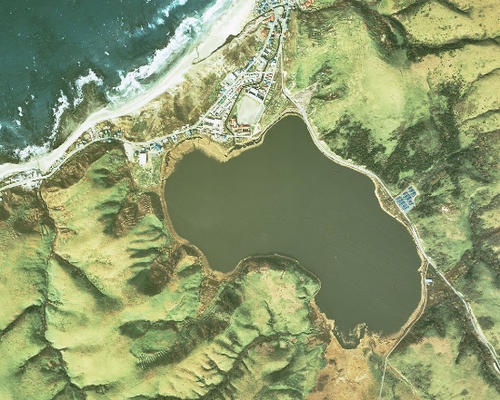Vegetation changes and human impacts on Rebun (NW Pacific) during the last 6000 years
Aerial view of Lake Kushu
Image Credit: The Geospatial Information Authority of Japan GSI CC BY
Knowledge about climate and environmental variability during the last 6000 years is of particular interest for modelling future climate scenarios. Unlike the early Holocene (11700-8200 years before today), the last 6000 years were not influenced by the effects of glacial retreat, but were characterised by environmental conditions comparable to those today. Therefore, climate variations during this period are better analogues for future climate changes. To better understand spatio-temporal relationships of the different parts of the global climate system, it is necessary to obtain climate records from all parts of the world. Japan is still one of the regions from which only few meaningful paleoclimate data are available. Furthermore, it is an important social concern to learn more about how prehistoric societies dealt with climate change, respectively how and from when humans themselves changed their environment.
The data
The data comprise high-resolution, robustly dated pollen and spore records from Lake Kushu (Rebun Island, northern Sea of Japan, Hokkaido region) and records of botanical remains (seeds, root tubers) from cultural layers of the nearby archaeological site Hamanaka 2.
The records each contain the absolute counts of the taxa represented and the measurements and weights of the barley seeds found from Hamanaka 2. In addition to the fossil pollen data, pollen spectra from surface samples collected on the island are also published. In addition, photographic documentation of the most abundant pollen types is provided.
Publication of the data set: Leipe C, Müller S et al (2018) https://doi.pangaea.de/10.1594/PANGAEA.890926
Research results
In this study, fossil pollen and spores from deposits of Lake Kushu were investigated. The pollen and spore records are precisely dated and provide the first high-resolution insight into vegetation and climate changes during the last 6000 years in northern Japan.The data show that the long-term continuous trend towards lower annual average temperatures was superimposed by short-term (decadal) cooling phases. On the one hand, these short-term temperature fluctuations correspond to climate changes known from other parts of the world. Nonetheless, these phases partly coincide with upheavals in the prehistoric and early historic cultural succession of Hokkaido.
Besides the reconstructed climatic changes, evidence of human activities on Rebun Island is also discussed. Declines in forest cover and an opening of the landscape, visible in the pollen and spore records, are evidence of clearing. One of the strongest clearing phases (c. 1500-1000 years before present) coincides with the settlement period of the Okhotsk culture. Together with zooarchaeological evidence, the archaeobotanical data show that the basically savage Okhotsk communities, who probably migrated from the Amur region to Hokkaido around 1500 years before present, had a wide food spectrum and even cultivated barley. It is also possible that deforestation is related to an increased demand for land for grain cultivation. With the beginning of the decline of the Okhotsk people in northern Japan, the forest on Rebun was able to spread again from about 1200 years before today. The study impressively demonstrates the complex web of natural climate changes and the effects of human activities that have always shaped landscapes and human-environment relationships.
Publication of the journal article: Leipe C, Müller S et al (2018) https://doi.org/10.1016/j.quascirev.2018.06.011
Texts modified after: Leipe C, Müller S et al (2018) https://doi.org/10.1016/j.quascirev.2018.06.011
